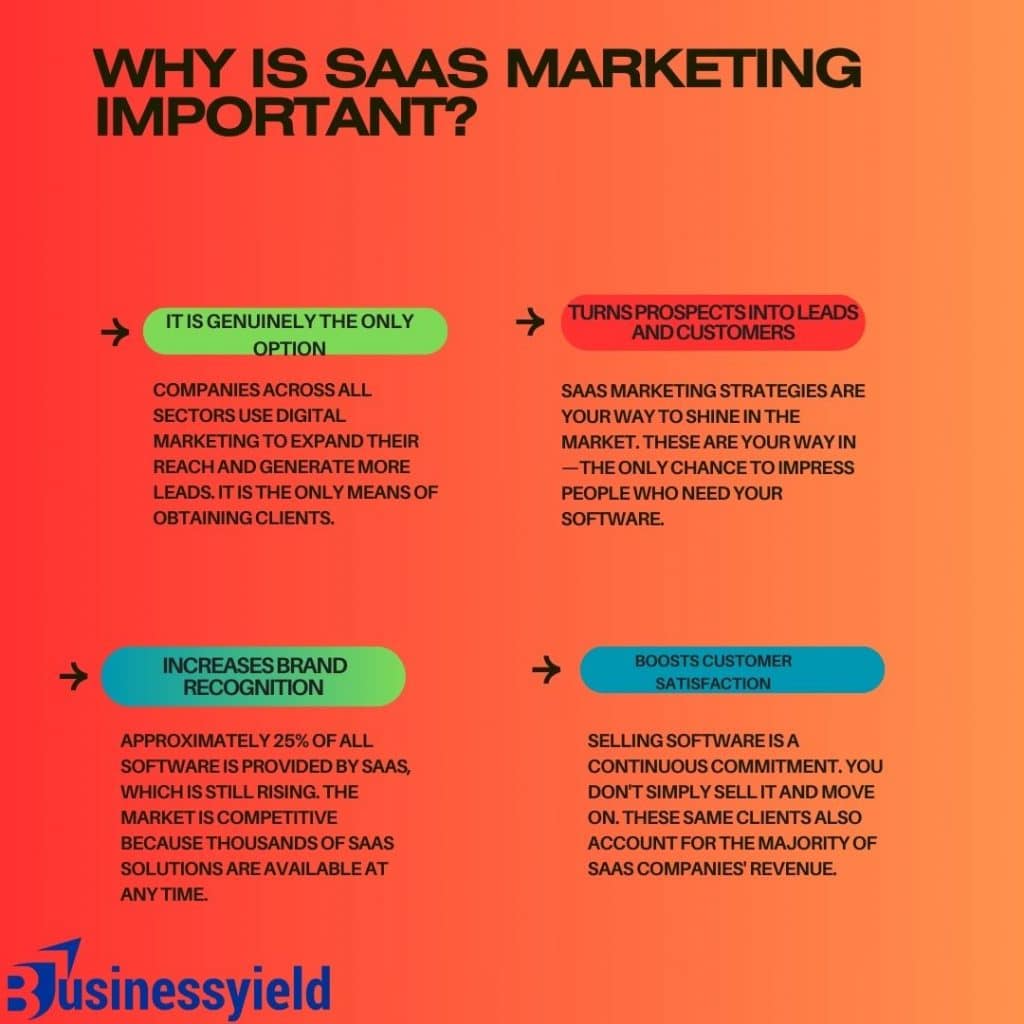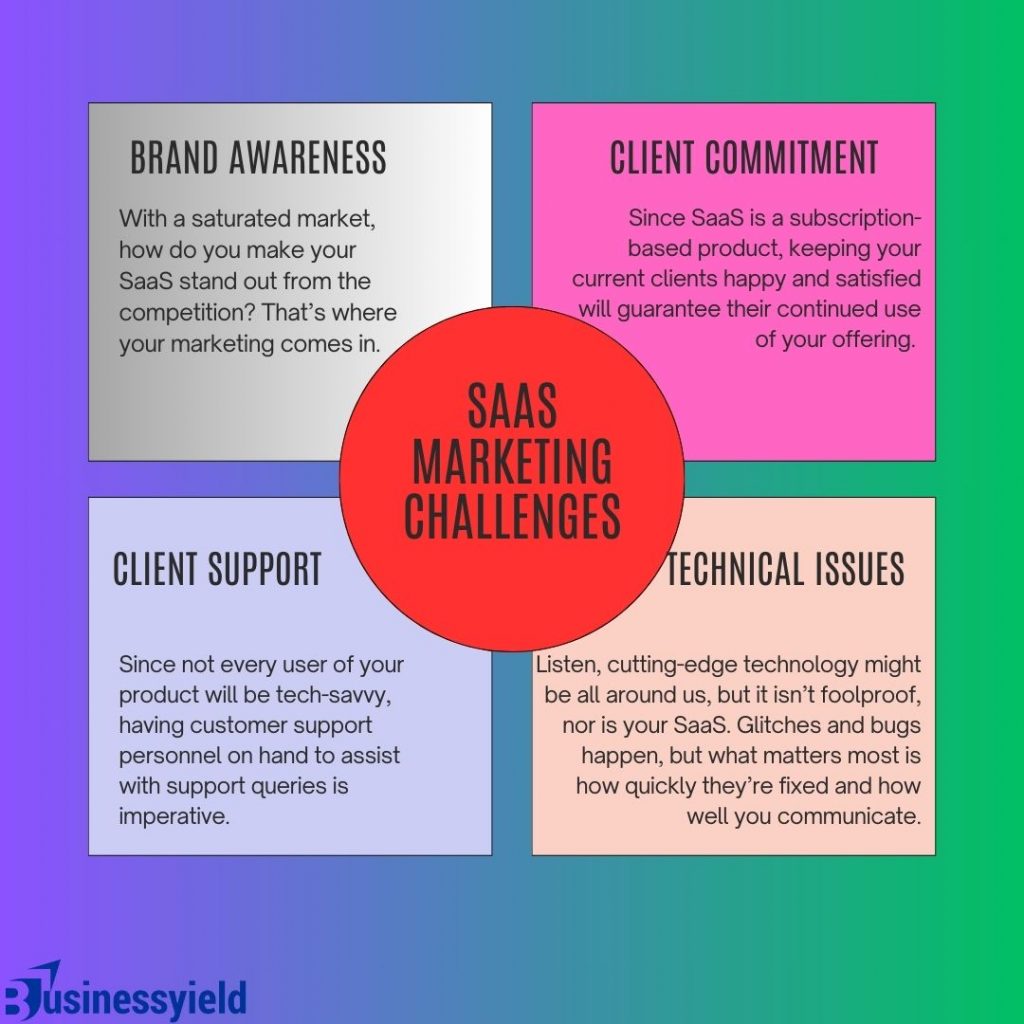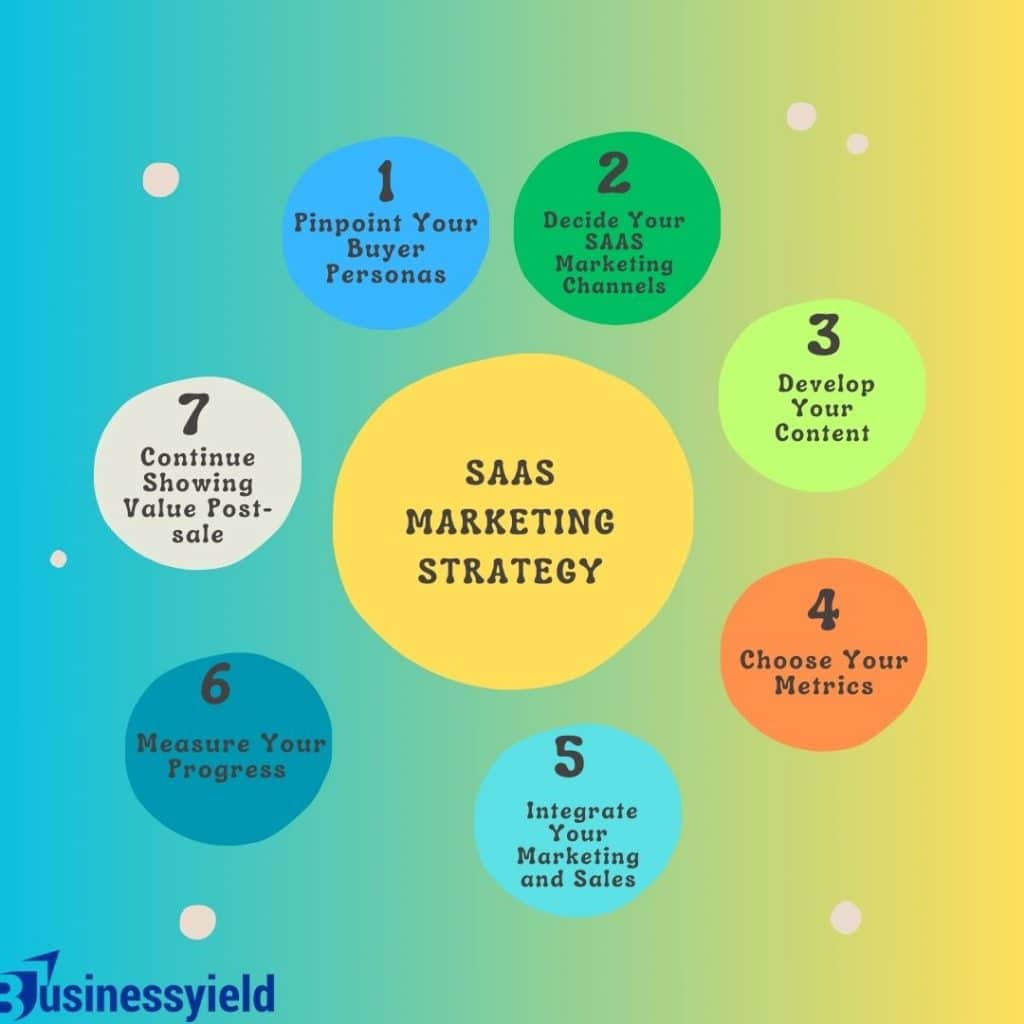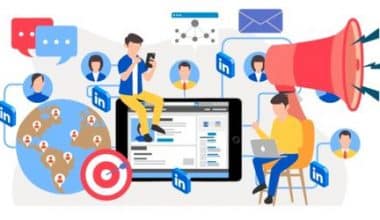If you work in SaaS marketing and are seeking tips on improving the outcomes of your marketing strategy and stepping up your efforts to sell more SaaS, you are in the right place. I have assembled this marketing content with global SaaS industry experts and our internal experts.
I’ll discuss how to develop more effective marketing techniques for your SaaS company shortly. By implementing these SaaS and other business marketing techniques and approaches right now, you will observe a boost in product signups and, eventually, revenues.
However, before we explore these strategies, we must have a firm grasp of SaaS marketing.
Key Points
- SaaS (Software as a Service) marketing strategy involves a combination of techniques for promoting and selling software applications hosted in the cloud and accessed via the Internet.
- SaaS marketing strategies aim to convert potential customers into subscribers willing to commit to monthly or annual plans.
- Digital marketing is not the same as SaaS marketing. Digital marketing sells products through online platforms and then repeats the sales cycle to bring in new customers. On the other hand, SaaS marketing fosters a solid rapport with every client by offering the same service every month, eventually contributing to recurring income.
- Brand awareness, client commitment, client support, and technical issues are challenges every marketer faces when promoting their product or service, and SaaS is no different.
What Is SAAS Marketing?
SaaS marketing is an aspect of marketing that concentrates on advertising and lead generation for subscription-based software solutions. To suit the unique needs of a client company, they can additionally tailor updates and products.
SaaS companies constantly seek new ways to encourage upgrades and expand memberships. They often base their subscription rates on how much data a client uses or how many users a business adds to their plan. SaaS marketing ensures that new offerings are known to current customers and that there is visibility on the market to draw in new ones.
What Makes SaaS Marketing Different?
SaaS marketing is different because it offers a continuous, subscription-based service. Unlike traditional products with a single point of sale, clients pay for SaaS solutions monthly or annually.
Because of this, the goals of traditional and SaaS marketing are different. A traditional marketing strategy aims to turn prospects into customers who purchase a single transaction of a product or products. These clients might make more purchases if they are satisfied with the merchandise.
The goal of SaaS marketing strategies is to convert potential customers into subscribers who are willing to commit to monthly or annual plans. When these plans expire, you’ll want your clients to renew and recommend your service to others.
In other words, traditional plans focus on per-transaction revenue, while revenue is gradually given priority in SaaS plans.
Terminology Used in SAAS Marketing That You Ought to Know
The following terminology can help you understand SaaS marketing:
- Net promoter score: This is the likelihood that a customer will advocate for a company or item. To find this value, you can use a one-question poll asking customers about their likelihood of promoting the product.
- Customer lifetime value (CLV): This is the typical value a paying client contributes to a SaaS business via their subscriptions. This figure can be computed by multiplying the subscription length by the subscription price and dividing the result by the total number of users.
- Monthly recurring revenue (MRR): This is the total revenue an organization earns each month from the subscription fees.
- Customer acquisition cost (CAC): This is the cost of acquiring a new, paying client through marketing. It can be computed by dividing the marketing channel’s total costs by the number of paying clients it brings in.
- Customer churn rate: This represents the proportion of users that revoke their subscriptions at any time. You can calculate this value by dividing the number of users left in the period by the total number of existing users and multiplying by 100.
What Is the Difference between Digital Marketing and SAAS Marketing?

Digital marketing is not the same as SaaS marketing. Digital marketing sells products through online platforms and then repeats the sales cycle to bring in new customers. On the other hand, SaaS marketing fosters a solid rapport with every client by offering the same service every month, eventually contributing to recurring income.
SaaS marketing differs in that it does not involve a single sale. Creating lifelong value for your customers requires specialized marketing abilities in this paradigm. For example, if your product is being marketed through a subscription model, you must demonstrate to your clients that your SaaS solution is worth the monthly cost. It also implies that you must regularly provide incentives and update your product to stay ahead of the competition.
SaaS marketing requires a unique viewpoint and strategy to attract, close, and retain customers.
Why Is SAAS Marketing Important?

Why would you need SaaS marketing when you already have an amazing product and have made it available online?
Like anything else you’re selling, you need marketing to reach the target audience and turn prospects into leads. How else will people know about your software, or, more importantly, how else will they build the desire to subscribe or purchase?
If you aren’t convinced yet, here are the 4 main reasons to pursue SaaS marketing.
#1. It Is Genuinely the Only Option
Companies across all sectors use digital marketing to expand their reach and generate more leads. It is the only means of obtaining clients.
And why?
This is because you are providing a digital good or service. Software is what you’re providing as a service. They can’t go to the store and pick it up in a bag or order it by mail. It must, therefore, be marketed to those who will need it and will undoubtedly use technology to obtain and utilize it.
Digital marketing is necessary to achieve your objective of selling software as a service. You must employ powerful SaaS marketing techniques like Canva lists to get users to see and use your software.
If you’re having trouble with this, popular marketing tools like Canva can also guide you through the steps and assist you in releasing your software into the public eye. This strategy will help you outperform your rivals and connect with your target market.
Either way, you need SaaS marketing because it is not the best option; it is your only option.
#2. Turns Prospects into Leads and Customers
SaaS marketing strategies are your way to shine in the market. These are your way in—the only chance to impress people who need your software.
Let’s name your product Z. You don’t just need SEO optimization to get people to learn about software Z. Good marketing will get you to the point where Z reaches people who might be interested. But then, you need even more thorough marketing to show them that Z is what they’ve been looking for.
This part of SaaS marketing makes it so different from other marketing. Since the software is not tangible and not something you sell physically, people can’t know what you’re offering unless they try it (and tell them about it).
That’s why freemium is so effective in SaaS marketing. Neil Patel, an expert in marketing, shares that giving away freemium SaaS products can be highly beneficial. He says, ” Giving away free stuff is actually a good thing.”
This won’t sound like a good idea for traditional sellers who create and sell physical products. They might send a small sample occasionally, but an image and a description are usually enough to get people to buy the product.
Giving freebies is exactly what SaaS marketers do. This is a widely accepted strategy for onboarding and customer acquisition. Once people notice Z, you need to show them what it does.
Otherwise, why would they buy Z if they don’t know what it offers them?
#3. Increases Brand Recognition
Approximately 25% of all software is provided by SaaS, and this number is still rising. The market is competitive because thousands of SaaS solutions are available at any time.
You should focus on outperforming the competition unless you have something special, something no one else has, and something that a particular set of individuals needs.
Competitors will likely surface once your software idea generates leads, even if yours is the most original. This means that branding your software is more crucial than ever. People should be aware of the name as soon as they hear it. What your software is should be obvious. That’s the main goal of SaaS marketing.
#4. Boosts Customer Satisfaction
Selling software is a continuous commitment. You don’t simply sell it and move on. These same clients also account for the majority of SaaS companies’ revenue. If you’ve entered this field, you should know your clients are here to stay.
While you should always seek to acquire new leads and clients, the ones you currently have are priceless.
People must be happy with your software and service to keep using it. You only have that much time to make an impression on the user and persuade them to make another purchase or subscription, as most SaaS solutions are subscription-based and purchased for a limited period. This is when Whop and similar services are useful. They offer SaaS subscription management software, helping you to boost subscriptions, retain users, and track growth trajectories. You can’t hope to keep customers satisfied if you aren’t tracking why people are unsubscribing, so subscription management is vital to keep growing.
Customer retention is critical in this industry. As RiverSaaSCapital says, “You have to retain to sustain.”
SAAS Marketing Challenges
I’ve encountered a wide range of difficulties in my experiences with SAAS marketing. Every challenge I’ve faced has tested my adaptability and resilience, from the complexities of client acquisition to the ongoing change of digital environments. Field experience further refined my talents, showing me the delicate balance between scalability and individual interaction. Navigating through the competitive landscape, I’ve learned to tailor strategies to meet the diverse needs of target audiences while staying true to our brand ethos. Throughout it all, I’ve come to appreciate real connections and the effectiveness of lifelong learning. SAAS marketing is more than just a profession; it’s a growth path where every obstacle presents a chance for creativity and success.
Every marketer who wants to promote their goods or services must overcome obstacles, and SaaS is no different. Here are a few of the most common challenges and how to address them:

#1. Brand Awareness
With a saturated market, how do you make your SaaS stand out from the competition? That’s where your marketing comes in. Your focus should be understanding and targeting your ideal customers, and creating unique educational and informational content.
#2. Client Commitment
Since SaaS is a subscription-based product, keeping your current clients happy and satisfied will guarantee their continued use of your offering. This can be accomplished by ensuring they are well-versed in your product through an excellent client onboarding process. Another way to ensure clients feel heard and noticed is to release new features or address frequent bugs.
#3. Client Support
Since not every user of your product will be tech-savvy, having customer support personnel on hand to assist with support queries is imperative. It’s wonderful to have 24/7 help available, but it can be costly and unnecessary as long as customers can quickly obtain the necessary answers. Additionally, it’s a good idea to open multiple communication channels, including phone, email, and live chat.
#4. Technical Issues
Listen, cutting-edge technology might be all around us, but it isn’t foolproof, nor is your SaaS. Glitches and bugs happen, but what matters most is how quickly they’re fixed and how well you communicate. Offering customers open communication and solid support can distinguish between them sticking with you or jumping ship.
SAAS Marketing Strategy

From what we’ve discussed, it’s clear that SaaS products are marketed to specific clients who are willing to sign up for the long haul. SaaS (Software as a Service) marketing strategy involves a combination of techniques for promoting and selling software applications hosted in the cloud and accessed via the Internet.
The SaaS marketing strategy mainly comprises these steps to sell the product, and each step requires a different marketing approach. I have provided 7 techniques for creating a marketing plan for massive ROI
#1. Pinpoint Your Buyer Personas
A buyer persona is a semi-fictional representation of your ideal customer based on data and market research on your existing customer base. Once you have the right information, a marketer can pull a larger story out of the details that help you address the right concerns for your audience in your messaging.
But what’s unique about audience research in SaaS, and what do you need to know to establish a good SaaS customer acquisition strategy?
A great place to start is by looking at a typical customer journey within the SaaS marketing funnel. Here are a few things to guide where you focus at each stage:
Awareness
SaaS customers are often in the market for a new solution because 1) they hate their current tool or 2) they need to do something new that their current tool isn’t capable of doing. Research your competitors and what your target types of customers are discussing in professional spaces (like LinkedIn) to find specific points to address in your messaging.
Consideration
As we’ve already mentioned, SaaS is somewhat abstract. Therefore, you must offer many clear documents that showcase your product. Infographics, videos, and tutorials are especially useful in this situation.
Decision
A fundamental component of SaaS marketing is providing demos. They offer a far more alluring first step in customer engagement than merely speaking with a representative. Demos are also the most effective way to demonstrate what your clients purchase. Here, a guided demo that gives a decent overview of the onboarding procedure is also a wise choice.
Here’s an example of a customer persona:
Mark B’ Hilary is a 28-year-old white man who lives in Seattle with his girlfriend. He works for a successful marketing agency and makes $200,000 per year. Mark enjoys staying current on technology trends, aspires to start his marketing agency, and gets news from social media outlets and technology magazines.
Below is a downloadable template guide on how to create a buyer persona:
Businessyield Template Guide on How to Create a Buyer Persona
#2. Decide Your SAAS Marketing Channels
Once you’ve identified your target audience, select which marketing channels are the most appropriate for your software. Some of the channels you might consider are:
- Radio
- Television
- Social media
- Podcasts
- Blogs
- Billboards and external signage
To ensure campaign visibility, refer to your customer personas to identify channels they’d use. If your customers spend most of their time online, you’d likely do well to push your campaign on social media rather than through print media.
#3. Develop Your Content
In my opinion, content marketing is especially beneficial for SaaS because, when done well, it demystifies your product and helps prospective buyers understand how it can meet their needs.
Content to attract
Considering how crucial organic leads are to SaaS success, improving your website should be your priority. You need a resource centre that provides your consumers with useful, evergreen information to answer their queries and product and solution sites tailored to the language your customers use. As previously discussed, this material must address needs at each funnel level. Remember that your clients frequently look for solutions online before they even realize they need them. Early on in their journey, being in front of them creates awareness and trust, which positions them for success.
Content to convert
You need to have clear, consistent language that communicates your value and extra content (graphics, videos, guides, case studies, etc.) that goes into the specifics of what your solution can achieve once you’ve gotten clients to your site through paid advertisements or organic search results. Make sure you have a ton of stuff here that leads to that conversion point if you can offer a demo.
Leads and conversions are generated by effective content marketing. A SaaS content marketing agency can help you guarantee that your messaging is effective and achieves both leads and conversions, which is important if you want to build a pipeline for your organization that keeps delivering.
#4. Choose Your Metrics
Before starting your first SaaS marketing campaign, consider the metrics you will need to gauge its performance. By using these indicators, you can more quickly determine the ROI of each campaign, pinpoint areas that need work, and keep refining your efforts so they continue to yield improved outcomes over time. Your stats may change depending on your goals and the marketing channels you select. Typical metrics to take into account are:
- Number of people reached, or cost per person reached
- Number of engagements or cost per engagement
- Number of views or cost per view
- Number of clicks or cost per click
- Number of landing page views or cost per landing page view
- Number of conversions or cost per conversion
- Churn rate
- Conversion rate
- Click-through rate
- Customer retention rate
- Number of active trials
- Number of followers gained on social media
- Sign-up-to-paid conversion
- Customer acquisition costs
#5. Integrate Your Marketing and Sales
It’s not just SaaS that needs alignment; your sales and marketing teams should also work together on a few industry-specific issues:
Cost structures: Your product’s subscription model is a crucial component. You might be amazed at how frequently marketing teams are left in the dark, even if your salespeople are well-versed in this information. Although pricing information need not be disclosed in your marketing materials, knowing what is available at each tier will greatly influence your marketers’ messaging and content.
Pre-sale value: Salespeople can guide prospective customers through demos, one-on-one consultations, and presentations never used for marketing. If you offer this kind of extra value to customers before they buy, make sure to 1) let marketing know and 2) allow them to offer feedback on the messaging.
Technical information: Sales constantly possess information that Marketing is unaware of. You may frequently field inquiries from potential customers asking whether your product works with other particular apps. Your messaging may never highlight this fantastic benefit if you don’t provide your marketing team with this information.
In addition, keep your team updated on product details; something that appears insignificant to your sales team may spark creative brainstorming in the marketing department. B2B SaaS solutions are complex and can only be available to certain team members. If everyone is knowledgeable about the specifics of the product, you’ll be able to give your customers the best possible experience.
#6. Measure Your Progress
No SaaS marketing strategy is complete without a clear description of what you’re measuring, how often you’re measuring it, and what results you want. By defining metrics before you start, you’re better prepared to ensure that outcomes align with expectations.
#7. Continue Showing Value Post-sale
I’ve mentioned it a few times, but I want to drive it home: the SaaS post-sale phase is incredibly important for customer retention and referral marketing.
SaaS’s subscription model implies that sales are continual, so onboarding initiatives and customer support are crucial. After the transaction is finalized, you must prioritize the client’s adoption by providing walkthroughs and allocating resources to answer client queries. During this phase, you may be engaging with staff members who don’t hold decision-making authority inside their company. Remember that their tool utilization will frequently dictate your success, so give them lots of attention and encouragement to keep them on board.
Customers might rely less on you as they grow more accustomed to using your product, but you must remain prepared to assist them when new difficulties arise due to special needs on their end. By remaining actively connected, you will also have the chance to recommend improvements or new features that are ideal for your client.
SAAS Marketing Examples

How do these SaaS marketing strategies translate into real life? Let’s take a look at some examples:
#1. SEO – RingCentral
RingCentral is a heavyweight in the global cloud communications solution game, and it has been a leader in the Gartner UCaaS (Unified Communications as a Service) Magic Quadrant for eight years in a row.
Despite these successes, RingCentral felt the strain of a crowded UCaaS market. In addition to boosting organic and non-branded traffic to their website, they aimed to broaden their core service offerings into the US, UK, French, and German audiences.
How did they achieve this? By concentrating on creating their on-site content while utilizing digital marketing.
#2. Freemium – Slack
How many advertisements have you seen for Slack? They could try to trick you into believing you haven’t been observing, but they hardly ever promote.
Word-of-mouth has helped them become one of the most popular SaaS products. Let’s examine how they achieved it.
Irreplaceable product
Initially, Slack provided an undiluted Freemium version of their entire product. After using their product for a while, individuals could not imagine working without it because it worked so well in their workflows.
And they went one step further and offered unmatched customer service.
Slack was well on its way to becoming a top SaaS provider once word spread about its excellent product and customer support in offices and on social media.
Not time-based trial period
Another genius decision by Slack was to give a message-based trial period for their Freemium service instead of a time-based one.
Generally speaking, trial periods range from 15 to 30 days, after which a consumer must upgrade. Because Slack built its trial period around messages, companies were alerted when their message capacity was reached and an upgrade was necessary.
A business would upgrade at this point because it had already invested in the product, and Slack proved that to be effective. Their customer lifetime value grew, and their conversion rate fell.
#3. Referral Marketing – Dropbox
Everyone is familiar with referral marketing. It’s common to say, “Refer a friend, and you get such-and-such off a future purchase,” to attract new clients. Dropbox elevated this to a new level with its incredibly effective referral marketing strategy.
Embedded in the onboarding process
Integrating a playful, user-friendly image into the onboarding process to facilitate referrals was crucial to Dropbox’s success.
The attractively designed website includes a call to action to upgrade if customers require even more storage. Users can easily monitor their progress toward free storage.
Crystal clear terms
Dropbox lays it out clearly, and that’s important to its marketing success. The user gets a certain amount of free storage by referring a friend. The more referrals you bring in, the more free storage you get.
One-click referral process
The final piece in the puzzle is the one-click referral process. Users can easily send a referral request to their contacts by adding emails or copying a shareable link.
Bottom Line
These days, SaaS is widely utilized and beneficial. Your decision to develop your software as a service was motivated by this. This is crucial for humans. It gives them constant access to answers for many of their issues and eliminates the hefty expense of acquisition as well as expenses related to updates and upkeep.
However, for people to start considering your product as a solution, they must become aware of it. Before they buy anything, they must locate it, comprehend it, want to test it out and be impressed. You need SaaS marketing for all of this to take place. It’s the only and best method to draw attention to your SaaS. You must also take long-term steps to attract subscribers, maintain their attention, and increase brand recognition for your work.
Similar Articles
- B2B SOFTWARE: The Best B2B Software in the Market to Drive Success in 2023
- Saas Sales: Ultimate Guide to The Saas Sales Process and Metrics
- SAAS BUSINESS MODEL: How it Works, Examples & Template






